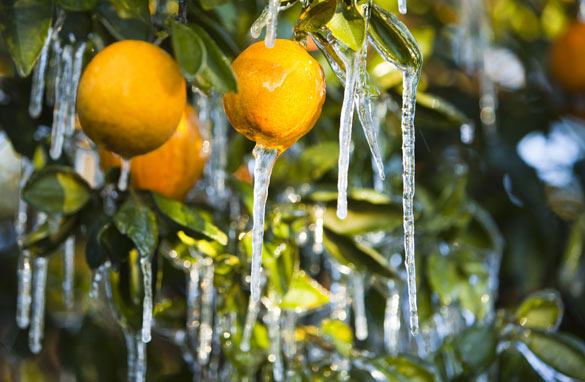naturalnews | Simply
put, when nature deviates from its normal cycles, it throws food
production into chaos. A one-night drop below freezing, for example, can
wipe out the entire citrus crop in Florida. A Midwest drought recently
collapsed corn production there, and almost two years ago, a severe
drought in Texas caused a collapse in grazing grasses, resulting in a
mass slaughter of starving cows that could no longer be fed. The upshot
of that was plummeting beef prices, followed by a spike the next year as
herds had been thinned out far beyond normal.
Here's what you need to remember and weather and food prices:
Stable weather = cheap food
Radical weather = expensive food (or no food at all)
The
"latency" between the radical weather and resulting food prices is
anywhere from one month (for fresh produce) to a full year (for
processed, manufactured foods). This means that crazy weather patterns
today might not spike food prices until next year, depending on the
crops in question.
Because the weather is becoming more radical,
food prices are trending sharply higher. The USDA, which downplays food
inflation for political reasons, admits that food prices rose 3.7% in 2011, 2.6% in 2012 and are currently rising at 3% in 2013.
These
numbers are artificially low, of course, as is readily evident at the
grocery store right now. But even when kept low, they still portray an
alarming scenario when you consider these food price increases are compounded annually.
That means they pile on top of previous year's increases, causing the
resulting price spikes to rise faster than might be expected by
intuition alone.
For example, if food prices increase at just 3.5% per year, they will double every 20 years.
But the actual food inflation we seem to be experiencing when you consider the real products that people buy is closer to 6%. And at 6%, food prices double every 12 years!
Food production is extremely resource intensive
For
food prices to drop, food production inputs must fall in price at the
same time weather patterns become more predictable. This is extremely
unlikely to occur any time in the foreseeable future, especially with
fresh water, topsoil and fuel all becoming increasingly scarce and therefore more expensive.
For those who don't know, farming is extremely resource intensive,
using enormous quantities of water and fossil fuels to produce food.
For example, it takes 1,000 liters of water to make 1 liter of milk.
Similarly, it takes 15,400 liters of water to produce just 1kg of beef.
A very informative website that explains all this is:
Also check out:
This report shows that the "water footprint" of a typical U.S. citizen is a remarkable 2,842 cubic meters per year.
That's three quarters of a million gallons of water PER PERSON, per year.
Once
you understand this relationship, you'll understand why rainfall and
weather patterns are so crucial to the food supply. Just one inch of
rainfall on just one acre of land delivers 6.2 million cubic inches of water to the land (and whatever is growing there). That's 27,000 gallons of water per acre with just a one-inch rain.
In a drought, large pieces of land are subjected to huge water deficits
running in the billions of gallons. Under such conditions, edible
plants simply cannot grow, and even grazing animals like cows are unable
to even maintain current weight.



11 comments:
naturalnews is a larouchian front, thus the deeply self-conflicted chindribble about chemtrails, HAARP, coupled with denial of fossil fuel provoked anthropogenic climate change - nevertheless....,
Right away I am going to do my breakfast, once having my breakfast coming over again to read more news.
Also visit my blog; registry cleaner review
Nice article, it shows your dedication, expertise and way of working. Thanks for the share. Escorts London
This is our 5th year of urban gardening. During March I was still picking Georgia collards and chard that we planted in September. Hated to turn the garden over but the spring plants had to go in the ground. It's been so cold this spring in Carolina we've had to plant and replant. This week we got hit with torrential downpours. Difficult gardening this spring. It's probably a national theme.
I've held off watching the weather spectacle and waiting for the firesale clearances on saplings and materials. I've been quietly replacing everfything ornamental with fruit bearing trees and bushes
Have chickens yet? They're great for taking care of kitchen scraps plus the eggs are delicious and healthy (compared to store bought). They need very little attention and will fertilize your lawn, trees and bushes like a thug.
Chickens wouldn't go over too well in the neighborhood. Notwithstanding all the practical value you've noted, the Mrs. wouldn't allow any of her acreage to be that green either. )^:
Some of the more upscale neighborhoods in these parts are starting to do chickens (hens only, of course) as it has become quite chic. The whole peacocking -- my coop is more upscale than yours -- dopamine hegemony thing put to good use... As for the spousal unit, I do often note how women tend to be of much impractical use ;-)
mebbe I can work that peacock/peahen angle somehow or another..., couldn't hurt to try and I have an area that would be ideally suited for it.
Try to get your neighbors to do the same. I don't even pick my fruit anymore - the neighbors do it for me - but a few times a year it comes back to me in Ball jars along with the fruits and vegetables from other's gardens.
That upscale (established, city) neighborhood does a yearly Tour de Coops put on by the neighborhood coop co-op... last I heard was 20 coops that 500 people toured.
Post a Comment